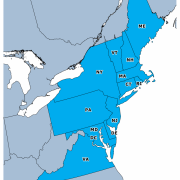FACT SHEET: Cap-and-Invest as a Tool to Reduce Pollution
Cap-and-invest is a policy tool that has been used in the United States and around the world to reduce harmful pollution.[i] Regional and state cap-and-invest programs have effectively reduced carbon emissions and other dangerous air pollution and strengthened the clean energy sector, all while growing the overall economy.
Cap-and-Invest Programs Explained
Cap-and-invest is an approach that limits the total amount of emissions from an industry or the whole economy. The total emissions limit—or cap—gets lower and lower over time, which means that less and less pollution is permitted from the capped sources of pollution, resulting in cleaner air and improved public health.[ii]
Each source of pollution—for example, a power plant or a petroleum fuel distributor—covered under the cap must hold an ‘allowance’ for every ton of pollution they are responsible for. The program administrator (for example, a state government) creates allowances equal to the total amount of pollution allowed under the cap for that year.
In many programs, the allowances are auctioned. Each regulated entity purchases allowances through the auctions to cover its emissions. Proceeds from the auction can provide funding for programs to further reduce emissions or to provide other benefits to households and communities, as determined by each state.
Cap-and-Invest as a Tool to Reduce Pollution
U.S. states have used programs like cap-and-invest to reduce pollution. For example:
- California has an economy-wide program that caps carbon emissions and invests proceeds. Since 2015, California’s Greenhouse Gas Reduction Fund has provided $9 billion for investments in cleaner vehicles, public transit, energy efficiency, and affordable housing.[iii] Quebec created a provincial cap-and-invest program consistent with California’s, allowing the two programs to “link,” or operate as a cohesive program.
- The Regional Greenhouse Gas Initiative (RGGI) is a regional cap-and-invest program for power plants in nine Northeast and Mid-Atlantic states (Connecticut, Delaware, Maine, Maryland, Massachusetts, New Hampshire, New Jersey, New York, Rhode Island, and Vermont).[iv] Each state uses its share of the allowance proceeds to fund energy efficiency and renewable energy programs and other measures that reduce electricity bills throughout the region. A 2016 analysis found that RGGI investments have resulted in $1.7 billion in lifetime energy bill savings for electricity consumers in this region.[v]
Transportation & Climate Initiative Regional Policy Design Process
 The Northeast and Mid-Atlantic states are working together through the Transportation & Climate Initiative (TCI) to accelerate the transition to a low-carbon transportation future and deliver better, cleaner, and more resilient transportation systems that benefit all communities, including those underserved by transportation options and disproportionately burdened by pollution.
The Northeast and Mid-Atlantic states are working together through the Transportation & Climate Initiative (TCI) to accelerate the transition to a low-carbon transportation future and deliver better, cleaner, and more resilient transportation systems that benefit all communities, including those underserved by transportation options and disproportionately burdened by pollution.
Over the course of 2019, the TCI states are designing a proposal for a potential regional cap-and-invest policy to reduce global-warming carbon emissions from transportation, working with communities and stakeholders and conducting analyses to help design a program that reduces pollution and improves transportation systems and public health.
The TCI states are considering a program that would:
- Put a declining “cap” on carbon pollution from burning fossil fuels in the transportation sector to reduce transportation emissions.
- Require large gasoline and diesel fuel suppliers to hold allowances for the pollution that results from the combustion of the fuels that they sell to consumers.
- Result in proceeds that can be used to fund programs to increase public transit and make it better and cleaner, build safe places for people to walk and bike to where they need to go, encourage electric vehicles, and more.
Learn More about Cap-and-Invest and the TCI Regional Policy Design Process
- For a more information about how cap-and-invest works and how it might be applied to transportation emissions, please see the Cap-and-Invest 101 video recording available here: https://www.transportationandclimate.org/tci-video-cap-and-invest-101
- Additional information on the TCI Regional Policy Design process, including a schedule of meetings and events, can be found on the TCI website: TransportationAndClimate.org
Download this Fact Sheet in PDF form:
[i] International Carbon Action Partnership, https://icapcarbonaction.com/en/
[ii] Graphic adopted from ‘Cap-and-Invest 101’ by Franz Litz, Litz Energy Strategies
[iii] California Climate Investments, http://www.caclimateinvestments.ca.gov/about-cci
[iv] The Regional Greenhouse Gas Initiative, https://www.rggi.org/
[v] The Regional Greenhouse Gas Initiative: Investments, https://www.rggi.org/investments/proceeds-investments
